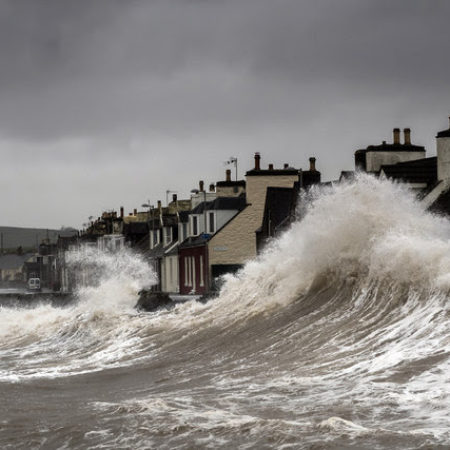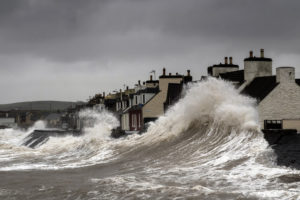As I write this Hurricane Matthew is pounding Florida, having already taken over 300 lives in Haiti. It is causing extensive damage on land as large areas of coastal Florida, Georgia and South Carolina are evacuating. Remembering Hurricane Sandy and witnessed the devastation that wreaked the Jersey Shore including the damage on our own home and the destruction in our town of Lavallette I know that it is scary and stressful to live through this. Thousands of people will lose their homes, belongings, memorabilia and sometimes their life savings. Some people will never be able to rebuild or will never be able to move back into the homes they once lived in. My own mother lost her home in Hurricane Sandy. Towns look like war zones after the storm rages through as they deal with trying to restore power, repair roadways and secure the safety of people. The loss of electricity will paralyze a city and create great risk for those with medical conditions. The residents and workers in these communities need our prayers.
There are many aspects of a hurricane that cause damage. The speed of the winds determine the category of a hurricane, ranging from 1 – 5. The higher the sustained winds, the higher the category. A category 4 hurricane will have sustained winds from 130 – 156 m.p.h. Of course the flooding waters are of major concern. Water causes more deaths than any other aspect of a storm and damage due to water is catastrophic. But the most problematic, unpredictable and most difficult aspect of a hurricane to deal with is the storm surge. A storm surge is a rise of water that can be as rapid as several feet in just a few minutes. The surge of water could be 8 feet or more, coupled with the waves and rising sea levels cause a storm tide. Waves push water inland faster than it can drain. The storm surge moves with the forward speed of the hurricane – typically 10-15 mph. This wind-driven water has tremendous power. One cubic yard of sea water weighs 1,728 pounds – almost a ton. This means a one-foot deep storm surge can sweep your car off the road, and even a 6-inch surge is difficult to stand in. Once on land the rushing water has tremendous power as well, carrying with it debris moving at high speeds. Trees, pieces of buildings and other debris float on top of the storm surge and act as battering rams that can cave in homes and buildings. Storm surges cannot be predicted, only prepared for.
Jesus knew about storm surges. As he concludes his Sermon on The Mount he says:“Therefore everyone who hears these words of mine and puts them into practice is like a wise man who built his house on the rock. The rain came down, the streams rose, and the winds blew and beat against that house; yet it did not fall, because it had its foundation on the rock. But everyone who hears these words of mine and does not put them into practice is like a foolish man who built his house on sand. The rain came down, the streams rose, and the winds blew and beat against that house, and it fell with a great crash.”
Today’s technology allows meteorologists to predict and track a coming storm. People are given time to prepare, to evacuate and to find shelter and safety. Still, one cannot predict every aspect of a storm, especially the storm surge. In life we have no such luxury. We generally don’t see the coming storms of life We don’t have time to “board up the windows” or to “evacuate.” We really have no way of anticipating life’s “storm surges”, those things that cause a storm to be even worse than expected. Life happens and we must deal with it. But Jesus instructs us to not get caught unaware. He warns us that storms do come and to expect rivers to rise and the winds to blow. In order to survive the storm we are to build our lives on a sure foundation. One that will sustain the winds. One that will hold steady through the surges. One that won’t b shaken to the ground in total destruction. What is the foundation? To hear the words of Jesus and put them into practice. That is a call to a relationship with Jesus where we are able to take in his words, mediate on them and let them shape our souls . It means time in Scripture allowing it to shape our minds and spirits. It requires that I say no to many things so that I can say yes to being in Scripture. And it means to take seriously the instruction of James when he writes in chapter 1 of his epistle:
Do not merely listen to the word, and so deceive yourselves. Do what it says. Anyone who listens to the word but does not do what it says is like someone who looks at his face in a mirror and, after looking at himself, goes away and immediately forgets what he looks like. But whoever looks intently into the perfect law that gives freedom, and continues in it-not forgetting what they have heard, but doing it-they will be blessed in what they do.
We always have a closing song at the conclusion of our worship service. I will close with this old but beautiful hymn: (Don’t worry, I won’t sing it).
1. My hope is built on nothing less
Than Jesus’ blood and righteousness;
I dare not trust the sweetest frame,
But wholly lean on Jesus’ name.
On Christ, the solid Rock, I stand;
All other ground is sinking sand.
2. When darkness veils His lovely face,
I rest on His unchanging grace;
In every high and stormy gale
My anchor holds within the veil.
On Christ, the solid Rock, I stand;
All other ground is sinking sand.
3. His oath, His covenant, and blood
Support me in the whelming flood;
When every earthly prop gives way,
He then is all my Hope and Stay.
On Christ, the solid Rock, I stand;
All other ground is sinking sand.
4. When He shall come with trumpet sound,
Oh, may I then in Him be found,
Clothed in His righteousness alone,
Faultless to stand before the throne!
On Christ, the solid Rock, I stand;
All other ground is sinking sand.
What do you think? How does it make you feel?



You must be logged in to post a comment.